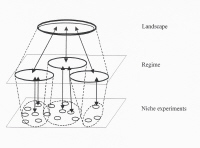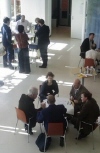About transitions
Summaries of the website's underlying scientific and practical insights that are based on the Knowlegde network on system innovations and transition are given below. See also www.ksinetwork.nl.
What are transitions?
Transitions or system innovations are radical innovations in the way societal functions are being fulfilled, for example the energy production and consumption function, food production and consumption, housing, mobility, health care. Transitions not only bring new practices but also changes in the 'regime': dominant institutions or structures that facilitate business as usual and hamper deviating practices. An example of the traffic regime are the roads, traffic lights, traffic rules, driving courses and licences. They help steering the traffic in the right direction and discourage deviant behaviour. The existing structure usually allows for incremental innovation, but not for radical innovation. That is the reason that system inonvation implies the innovation of structure, in any case of that (social) structure that opposes that innovation. Transitions, because of that, are socio-technical innovations and usually require one or two generations before they are completed.
Transition in agriculture
An example of a transition or system innovation is the development in the Netherlands after the two world wars, of large scale agriculture. The desire to produce sufficient food at low prices was a major driving force. The transition went togehter with rationalisation of production, mechanisation and specialisation. Small scale mixed farms disappeared and arable farming became separated from livestock farming. Within these categories some holdings specialised even more, for instance in poultry breeding or laying. Other structural changes added as well. For example, the Dutch government introduced product subsidies and started financing of university education, research and agricultural extension services to stimulate the development of knowledge and the application by farmers of the newest scientific insights. Land consolidation allowed for a more profitable use of land. Dutch banks granted loans to farmers to invest in the innovation and extension of their farms. Production increased enourmously, and the Netherlands became an agricultural exporting country.
During the transition, the authorities worked closely with organisations representing the farming community and agricultural experts in the Lower House of Parliament. The group was called the ‘IJzeren Driehoek' or the Iron Triangle. This new actor configuration would only be broken through, when new structural changes were neded due to political pressure because of environmental concerns and the excessive government costs of the product subsidy system.
Sustainable development and transitions
Sustainable development brings transitions or system innovations in its wake. The current dominant practices, in many domains, are under pressure because of their side effects. They include environmental pollution, exhaustion of natural resources, climate change and the financial crisis. Incremental changes of the excisting practices are not sufficient to meet these challenges. Instead, more radical redesign is needed: of our financial system, our mobility system, the way we build our houses, our energy and food production and consumption system. For example like in circular economy projects or like in the following examples in this website: that of the Riversimple company, which develops hydrogen cars and which uses a lease system including insurances and maintenance; the Energiesprong programme that realises zero energy cost houses; or Retenergie and Noorderwind that have developed new arrangements for decentral energy production.
The multilayer perspective
In the website, practical insights on working on transitions or system innovations are presented. One of the underlying scientific models is the multilevel perspective or multilayer model. It derives from research into technological innovations. The model demonstrates that transitions come about through changes in different layers. These layers reinforce each other:
- Niches with innovative, social, economic, technological or policy practices, that deviate and are protected from the dominant structure
- The regime that we introduced already in the beginning of this text: the structural layer that constitutes the context of common practice. This entails the institutions (sets of rules and procedures), physical infrastructure and culture including certain mental models
- The landscape: major social changes in the field of politics, culture and world views (such as globalisation and individualisation) or natural characteristics that are difficult to influence and usually change slowly. Landscape developments are the outcome of ideas and acts of a great many players.

Figure 1: Multilayer model
The model is relevant for strategic transition management. This begins with defining, for a transition project or programme, what the relevant landscape developments are; what the relevant regime or structures are; and related innovative niche projects. Relevant landscape developments have to be taken into account, since they cannot be influenced. Instead, one can only adapt or reframe the project or programme to make it more evident or attractive given the developments at this level. Unfavourable regime be changed, at least in principle, or one could start with finding a niche-regime with more advantageous conditions. See also Strategic Niche Management. Last but not least other, innovative niche projects are relevant, because one could learn from them, or align with those involved, in orde to realize regime change.
Research into transitions or system innovation has furthermore led to the following suggestions for transition work.
Emphasis on experimenting
Historical research into transitions and technological innovation reveals the importance of transition experiments: niche projects that can potentially contribute to (learning about) a desired transition. That's why recommendations for transition work place great emphasis on experimenting. The transition projects or experiments are connected with the developments at landscape level and with the changes to be brought about in the regime in accordance with the multilayer model.
The emphasis on experimenting derives further from the recognition that transitions involve uncertain, complex and dynamic processes. Many, diverse actors are needed for system innovations, from the different layers distinguished in the multilayer model, and often from different sectors and domains: from civil society (which include citizens and NGOs among others), the private sector, public authorities, the education and the science community. They have to arrive at new coordinated agendas, bring together diverse kinds of knowledge and skills and review their mutual relationship. But partly because they operate autonomously the process that brings this about cannot be taken for granted. In these circumstances experiments offer a good opportunity of developing new practices and structures while searching and learning.
Focus on learning
Besides experimenting the literature pays a lot of attention to learning. Researchers distinguish between the following types:
First and second order learning. One speaks of second order learning if people start rethinking their accepted truths. People develop these thought patterns through what they acquire from their social and cultural surroundings, their training and work. These are theoretical frameworks, deeply embedded convictions and values or worldviews. They determine how someone looks at a new problem. These ways of thinking also have a significant influence on the solutions that a person considers feasible. In the case of first order learning the mental model remains unchanged. First order learning normally results in limited changes in a person's perceptions and strategies. Second order learning, of individuals or a team, creates room for more radical innovation because the mental model has changed and this is what occurs in the case of system innovations. See also the examples of first and second order learning.
Convergent learning and system learning. A system innovation can only take place if the actors involved change their roles and aims in conjunction. In the literature about transitions and learning this is referred to as convergent or congruent learning. For this actors will have to learn to see structural bottlenecks not as given facts but as challenges. There is still little known about the suitable conditions for convergent learning, although it is clear that a sense of urgency and mutual dependency are conducive to it.
The above ideas about transitions, structural innovation, experimenting and learning are reflected in the five central themes: the clusters vision creation, making an action plan, societal anchoring, monitoring and evaluation and using competences.
Vision creation
 Quite a lot of the literature on transition explores the development of a vision or a long-term perspective. The long-term orientation helps people to extricate themselves from self-evident thought patterns and the straightjacket of the short term. The long-term perspective thus offers a sound reference point (Leitbild) for system innovative initiatives. The literature places emphasis here on the collective creation of a vision. It is through a joint process that those involved can learn about each other's mental models and become able to make adjustments to their deep convictions. The collective creation of a vision therefore supports more radical innovation rather than incremental renewal. The collective creation of a vision also helps in a practical sense because it can contribute to coordinating agendas and the strategies of those involved (convergent learning).
Quite a lot of the literature on transition explores the development of a vision or a long-term perspective. The long-term orientation helps people to extricate themselves from self-evident thought patterns and the straightjacket of the short term. The long-term perspective thus offers a sound reference point (Leitbild) for system innovative initiatives. The literature places emphasis here on the collective creation of a vision. It is through a joint process that those involved can learn about each other's mental models and become able to make adjustments to their deep convictions. The collective creation of a vision therefore supports more radical innovation rather than incremental renewal. The collective creation of a vision also helps in a practical sense because it can contribute to coordinating agendas and the strategies of those involved (convergent learning).
Making an action plan
.jpg) Transitions always involve structure or regime change. Schumpeter spoke of ‘creative destruction', new structures ousting the old. It is not a smooth process as research into system innovations reveals. That means that attention has to be paid in your action plan to structural changes. Strategic work needs to be done on change-oriented coalitions to overcome resistance. Insights into resistance within regimes initially prompted some researchers to advocate organising renewal primarily outside the vested interest structures (politics). But it has meanwhile become clear that the involvement of regime players is desirable, both for the legitimacy of the radical changes involved in transitions, but also because of the power and resources that are needed for change. An action plan therefore is about the forms of suitable coalitions for renewal, coalitions whose composition will have to change in the course of time and according to need.
Transitions always involve structure or regime change. Schumpeter spoke of ‘creative destruction', new structures ousting the old. It is not a smooth process as research into system innovations reveals. That means that attention has to be paid in your action plan to structural changes. Strategic work needs to be done on change-oriented coalitions to overcome resistance. Insights into resistance within regimes initially prompted some researchers to advocate organising renewal primarily outside the vested interest structures (politics). But it has meanwhile become clear that the involvement of regime players is desirable, both for the legitimacy of the radical changes involved in transitions, but also because of the power and resources that are needed for change. An action plan therefore is about the forms of suitable coalitions for renewal, coalitions whose composition will have to change in the course of time and according to need.
Societal anchoring
 The step from experiment to more general new practices is not an automatic one. Research shows that there are a number of reasons for this:
The step from experiment to more general new practices is not an automatic one. Research shows that there are a number of reasons for this:
- The experiments do not link up with the existing regime (the informal and formal rules, routines, protocols, knowledge, culture, roles and identity, the usual allocation of tasks between or within organisations)
- Management does not see the need or the urgency to work on institutional changes
- Changing the regime from outside the organisation is beyond the capacities of those who have taken the initiative for the experiment. Other people in other settings should take over the baton but will not automatically continue further with your ideas and experience. Even organisations that might want to experiment do not do it. The fact is that they do not know how. There is no money for a follow-up.
- A different government policy is needed to facilitate the new practices on a larger scale (such as new subsidy criteria, specific environmental rules, changes in government regulations about care). But the government is (still) not ready for this.
Systematic knowledge about what can be done about this is limited, but is growing. That knowledge includes among other things insights into the dynamic of innovation systems, of the necessary combination of innovators and regime players and about the strategic use of landscape developments.
Monitoring and evaluation
 First experiences with monitoring and evaluating system innovative initiatives show that the goals of these initiatives come up for discussion. There is a need to learn about making adjustments to the activities. This has to do with the dynamic and complex setting and the radical changes involved in system innovations. The focus of monitoring is also shifting. It is not just information about the planned and unplanned effects of one's own activities that is desirable for learning and making adjustments. Network analyses are also needed as well as information about niche experiments, and about the regime and landscape developments. The literature on the subject emphasises reflexive monitoring. This involves monitoring to learn and adjust and which is preferably a participatory process with those involved. It entails group reflection on the monitoring information and involves system learning and second order learning.
First experiences with monitoring and evaluating system innovative initiatives show that the goals of these initiatives come up for discussion. There is a need to learn about making adjustments to the activities. This has to do with the dynamic and complex setting and the radical changes involved in system innovations. The focus of monitoring is also shifting. It is not just information about the planned and unplanned effects of one's own activities that is desirable for learning and making adjustments. Network analyses are also needed as well as information about niche experiments, and about the regime and landscape developments. The literature on the subject emphasises reflexive monitoring. This involves monitoring to learn and adjust and which is preferably a participatory process with those involved. It entails group reflection on the monitoring information and involves system learning and second order learning.
Using competences
 Transition work is pioneering because it is about radical and uncertain innovations in the long term. There are no ready-made blueprints or protocols. Support for the change is uncertain. That demands special competences of the people who do transition work. The Dutch Competence Centre for Transitions has done research into competences, skills and roles that are needed for transition work and linked these to the four preceding themes. Basic competences proved to be networking skills, great communicative capacity and powers of persuasion and ability to mobilise. Other specific competences include the ability to think in terms of systems, visionary power, observational skills, creative skills, sense of timing and persuasiveness.
Transition work is pioneering because it is about radical and uncertain innovations in the long term. There are no ready-made blueprints or protocols. Support for the change is uncertain. That demands special competences of the people who do transition work. The Dutch Competence Centre for Transitions has done research into competences, skills and roles that are needed for transition work and linked these to the four preceding themes. Basic competences proved to be networking skills, great communicative capacity and powers of persuasion and ability to mobilise. Other specific competences include the ability to think in terms of systems, visionary power, observational skills, creative skills, sense of timing and persuasiveness.
Videos
The journey of sustainable business Text and pictures of ‘Greennovation' about the journey from the Industrial Revolution to the present.
Video Making Transitions Happen Platform of Climate KIC The video is an explanation of transitions or system innovations and of activities.
Further reading
Scientific publications can be found on the site of the Knowledge network for System Innovations and Transitions (KSI). Here you will find the legacy of six years of research by the knowledge network from 2004 to 2010. Or look at or www.transitionsnetwork.org, the website of the international Sustainability Transitions Research Network (STRN). The site www.sustainabilitytransitions.com has information on academic books on transitions and blogs.